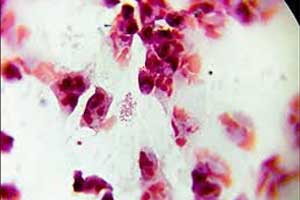- Home
- Editorial
- News
- Practice Guidelines
- Anesthesiology Guidelines
- Cancer Guidelines
- Cardiac Sciences Guidelines
- Critical Care Guidelines
- Dentistry Guidelines
- Dermatology Guidelines
- Diabetes and Endo Guidelines
- Diagnostics Guidelines
- ENT Guidelines
- Featured Practice Guidelines
- Gastroenterology Guidelines
- Geriatrics Guidelines
- Medicine Guidelines
- Nephrology Guidelines
- Neurosciences Guidelines
- Obs and Gynae Guidelines
- Ophthalmology Guidelines
- Orthopaedics Guidelines
- Paediatrics Guidelines
- Psychiatry Guidelines
- Pulmonology Guidelines
- Radiology Guidelines
- Surgery Guidelines
- Urology Guidelines
Sitafloxacin most effective for eradication of Chlamydia trachomatis among men

The available treatment options for chlamydia urethritis most common non-gonococcal urethritis in men include tetracyclines, macrolides and fluoroquinolones. The rising drug-resistant C. trachomatis infections have been reported worldwide but antimicrobial surveillance data remain scarce.
In order to study the status of drug resistance in clinical strains of C. trachomatis, Deguchi and colleagues examined C. trachomatis DNAs from first-void urine specimens from men with acute urethritis. The investigators utilized polymerase chain reaction (PCR) to detect the presence of fluoroquinolone resistance-associated mutations in the gyrA and parC genes and macrolide resistance-associated mutations in the 23S rRNA gene.
The researchers obtained a total of 284 DNA specimens positive for C. trachomatis from a urologic clinic in Sendai, Japan between April 2013 and December 2016. They detected no mutations in the 23S rRNA gene. Similarly, no mutations were found within the quinolone resistance-determining regions (QRDRs) of the gyrA gene and analogous regions of the parC gene. Amino acid changes of V61A and H129Q were found in the gyrA gene (44 of 118 DNA specimens, 37.3%), but these were not localized in the QRDR.
The authors stated that these amino acid changes found outside the QRDR of the gyrA gene do not contribute to the development of fluoroquinolone resistance.
In addition to the PCR analysis of urine samples, a retrospective analysis of clinical data of men complaining of acute urethritis symptoms between January 2013 and June 2017 was also performed. A total of 369 men whose first-void urine specimens were positive for C. trachomatis during their first visits were treated with either azithromycin-SR (2 g once daily for 1 day) or sitafloxacin (100 mg twice daily for 7 days). Outcomes of the antimicrobial therapies were assessed by re-testing the urine samples by APRIMA Combo 2 for C. trachomatis 21 to 60 days after treatment initiation. Of the 314 patients treated with azithromycin-SR, 176 were assessed for microbiological outcomes. Seven patients showed bacterial persistence and were deemed treatment failures. In contrast, of the 55 patients treated with sitafloxacin, 30 patients were assessed for microbiological outcomes. Sitafloxacin conferred 100% eradication rate.
The mutations associated with macrolide or fluoroquinolone resistance were not found in the C. trachomatis DNAs in the study. Considering the low treatment failure rate with azithromycin and the 100% eradication rate with sitafloxacin, the authors concluded that both fluoroquinolone and azithromycin regimens can be recommended as treatment of choice for urogenital C. trachomatis infections.
For further reference log on to :
DOI: 10.1016/j.jiac.2018.03.007

Disclaimer: This site is primarily intended for healthcare professionals. Any content/information on this website does not replace the advice of medical and/or health professionals and should not be construed as medical/diagnostic advice/endorsement or prescription. Use of this site is subject to our terms of use, privacy policy, advertisement policy. © 2020 Minerva Medical Treatment Pvt Ltd